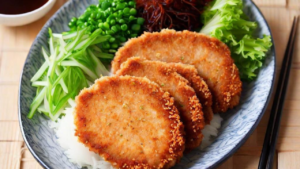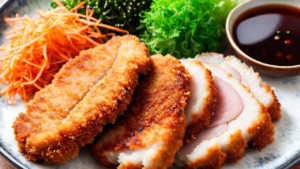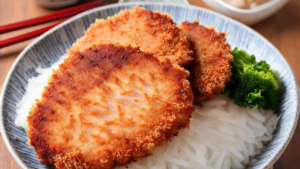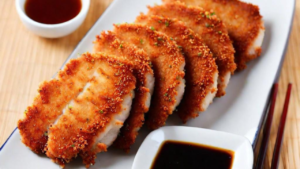INTRODUCTION
Donkatsu, often referred to as Donkkaseu, is one of the most well-liked meals in Korea, and it is about to wow your taste buds with its deliciousness. In an instant, you will fall in love with this pork cutlet that is inspired by Japanese cuisine. It is a treat that is both crispy and juicy. If you are in the mood for a dinner that will satiate your hunger or if you simply have a longing for something that is absolutely mouthwatering, donkatsu is the ideal option. I’m going to provide you with an introduction to the Korean method of preparing pork cutlets, which is referred to as “donkkaseu” in Korean. This dish is a variation on the Japanese tonkatsu, which was the Japanese equivalent of the schnitzel that was popular in Europe. In my rendition, the pork cutlet is served over a bed of rice and Hi-Rice sauce, with a side of kimchi and a side of cabbage salad. It is a hot, delicious, and breaded pork cutlet.
I’m going to provide you with an introduction to the Korean method of preparing pork cutlets, which is referred to as “donkkaseu” in Korean. This dish is a variation on the Japanese tonkatsu, which was the Japanese equivalent of the schnitzel that was popular in Europe. In my rendition, the pork cutlet is served over a bed of rice and Hi-Rice sauce, with a side of kimchi and a side of cabbage salad. It is a hot, delicious, and breaded pork cutlet. When I was younger, donkkaseu was only offered in restaurants that were modeled after Western cuisine and were referred to as Gyoungyang-sik. However, these days, donkkaseu can be found everywhere and in every kind of restaurant. In addition to selling hamburger steaks, beef cutlets, pork cutlets, omelette rice, and steaks, they also marketed a variety of other foods that were novel and intriguing. It was more expensive than Korean eateries, but it wasn’t completely Western either: every dish was served with kimchi and rice, and there was typically a pickle on the side as well.In those days, eating meals prepared in a Western style with a knife and fork was considered an unusual activity. However, these days, Western cuisine can be found everywhere in Korea. When I was younger, my pals would ask me, “Are you prepared to use a knife and fork today?” All of us were aware of what that signified! Oh, Donkkaseu! We were blown away by how fun it was!
In my experience, donkkaseu pairs exceptionally well with the Hi-rice sauce that I use; but, if you are unable to locate it, you can use plain gravy or even ketchup. I came up with the idea of using Hi-rice sauce for this dish, but it tastes a lot like the donkkaseu gravy that I used to get at those Gyoungyang-sik restaurants all those years ago. As soon as I took my first bite, I was transported back to my days in middle school and the restaurant where I used to hang out with my old pals.In the meantime, you may use this gravy to make donkkaseu. I will eventually create a recipe for hi-rice on my website and demonstrate how it is often utilized, but even so, you can use it to make donkkaseu.One of the strangest words in the English language is “donkkaseu,” and I had no idea what it meant until I started learning some English. The name “Don” originates from the Chinese character for pork, while the name “kkaseu” is derived from the Japanese word “katsu,” which is a loanword borrowed from Japanese for “cutlet.” Donkkaseu is the Korean adaptation of the Japanese meal known as “Tonkatsu.” The Japanese version of this dish is called “Thonkatsu.” Quite a humorous sounding phrase!
WHAT IS DONKATSU
It is commonly acknowledged that Donkatsu, which is also referred to as Donkkaseu (又蹌스), is the Korean rendition of the well-known Japanese dish known as Tonkatsu. The word “ton” originates from pork, whereas the word “katsu” is derived from the word “cutlet.” After being coated in panko bread crumbs, the pork cutlet is then deep-fried to obtain a golden brown exterior. This gives the cutlet a firm and crispy feel. I find it interesting that the French cuisine côtelette de veau is claimed to have been the source of inspiration for the Japanese dish Tonkatsu. It seemed to me that Schnizel was the one.

As a child who was raised in Korea, I was under the impression that donkatsu was a meal that originated in the West. It arrived with a knife and a fork, if you can believe it, isn’t that incredible? Absolutely great was the novelty! Of course, that is not all. An enticing cream soup would be served as an appetizer while you waited for the mouthwatering donkatsu. Additionally, they would provide you with freshly baked morning bread rolls, strawberry jam, and butter, all of which were prepared to go along with your donkatsu.
Now, if you have been following the traditional Korean menu consisting of rice, soup, and side dishes, you can readily picture how extraordinary this must have seemed to you! It seemed as if I had entered a completely new universe filled with delectable culinary experiences! In particular, we looked forward to these moments with great excitement, particularly on significant occasions such as birthdays or graduation festivities. As a result of the abundance of culinary options that are currently available in Korea, donkatsu has lost some of its uniqueness in recent years. On the other hand, it is still possible to locate it without any difficulty in restaurants that offer bunshik at reasonable prices, the food court at highway rest stops, and school cafeterias. Additionally, Korea is home to a wide variety of donkatsu dining venues, some of which are more authentically Japanese tonkatsu.
JAPANESE TONKATSU VS. KOREAN DONKATSU
If you are interested in learning more about the distinctions between Japanese Tonkatsu and Korean Donkatsu, you will discover that many Koreans acknowledge the following characteristics as being the most distinctive characteristics. Not only does this comparison take into consideration the pork cutlet itself, but it also takes into account the sauce that goes along with it and the side dishes that are served alongside it. It is my hope that you will find it fascinating to investigate these distinctions.
Thickness: The majority of Koreans highlight this as one of the most significant differences between the two countries. When compared to its Japanese cousin, donkatsu meat from Korea is typically described as having a more slender and broader profile. Additionally, it is believed that the Korean version appears to be more crispy.
The meal known as Wang Donkatsu (왕 돈까쓰) is one of my favorite donkatsu dishes prepared in the Korean style. It is often distinguished by its jumbo-sized pork cutlet that is spherical in profile. Not only is it satisfying, but it also has a captivating appearance. My pig loin, on the other hand, does not appear to be as huge as the one shown in the photographs throughout this page because I was unable to obtain a pork loin of this size for my recipe. During my recent trip to Korea, I had the opportunity to sample the well-known Namsan Wang Donkatsu (储산 왕돈까쓰), which is seen in the photograph below.
Sauce: The flavor of Japanese tonkatsu sauce is characterized by a sweet and tangy flavor that is obtained from ketchup and Worcestershire sauce. Japanese tonkatsu sauce often has a thick consistency. When compared to Korean sauce, I find that the sweetness of the tangy flavor in Japanese tonkatsu sauce is significantly more vibrant. In addition to this, the color is a somewhat darker shade of brown in comparison to its English counterpart.
The Korean version, on the other hand, has an aftertaste that is reminiscent of butter while yet retaining a savory, sweet, and tangy flavor. Nevertheless, it is essential to keep in mind that differences in taste can be subjective, on account of the fact that individual experiences can vary. It is possible for these variants to be influenced by the particular restaurant that one visits or by the home-cooked versions that one was raised with.
Serving Style: Traditional Korean donkatsu is often presented in the form of a huge, uncut chunk that is accompanied by a knife and a fork. On the other hand, Japanese tonkatsu is already sliced and is intended to be consumed with chopsticks before being consumed.
Side Dishes: Typically, shredded cabbage, miso soup, and rice are the accompaniments that accompany Japanese tonkatsu meal. In contrast, the traditional Korean dish known as donkatsu is typically served with rice, macaroni salad, and pickled radish or cucumber (or kimchi). In addition to that, it is frequently served with a cream soup that is both creamy and delicious, which makes for a satisfying dinner.
Ssamjang, which is a Korean spicy dipping sauce, and long green peppers are two of the side options that you can encounter. This is an even more unusual occurrence. The use of these distinctive Korean ingredients in conjunction with donkatsu may appear to be a strange combination; nonetheless, they complement each other quite well.
Getting a firsthand experience with both Korean and Japanese tonkatsu is without a doubt the most effective way to fully appreciate and comprehend the distinctions that exist between the two traditions. When it comes to deciding which option you would favor, your individual preferences and experiences play a significant impact.

MY VERY BEST SUGGESTIONS FOR AN IDEAL DONKATSU
TOP CHOICES OF MEAT CUTS
It is the pork loin fillet that is considered to be the ideal cut of pig for the preparation of donkatsu. Some grocery stores in Korea sell pork cutlets that have been cooked specifically for donkatsu. These beautifully sliced chunks feature slits all throughout the flesh, which not only aid to tenderize the pork but also flatten the meat, which facilitates a more rapid and even cooking process.
However, if you are unable to acquire these pig loins that have already been prepared, there is no need to be concerned because it is simple to create them at yourself.
The ideal thickness of the flesh is around one centimeter, or 0.4 inches. If you want to reduce the number of things you need to prepare, you should ask your butcher to slice it for you if at all possible. In the event that your butcher is not knowledgeable with Asian cuisine, please let them know that you intend to make schnitzel using the meat. This will allow them to comprehend the necessary degree of thinness.
CONTINUING TO KEEP DEEP FRY OIL FRESH
It is recommended that the deep frying oil be cleaned as rapidly as possible between batches in order to keep it in the best possible condition, prevent any discoloration or detrimental effects on the donkatsu coating, and preserve its optimal state. The only thing you need to do is use a strainer with a fine mesh to remove any fried crumbs that are still on the surface of the oil. It’s quite straightforward.
INTRODUCTION TO STORAGE AND DIRECTIVES FOR PREPARING IN ADVANCE
It is possible to prepare donkatsu in advance, and there are a few different ways with which this can be accomplished.
To begin, you can start preparing the pork loin in advance, right up until the point where you bread it. Before cooking, place the pork that has been breaded in the refrigerator for up to four hours to ensure that it has the best possible flavor and texture.
On the other hand, if you would rather cook your donkatsu and then freeze it, there is another alternative available to you. The donkatsu should be individually wrapped in cling wrap and placed in a freezer bag or a ziplock bag once they have cooled in the refrigerator. Once you are ready to consume it, simply remove it from the freezer and reheat it in the air fryer at a temperature of 200 degrees Celsius for ten minutes, turning it over halfway through the cooking process. Instead of throwing away fried donkatsu, you can store it in the refrigerator if you intend to devour it within a few days. In this scenario, reheat the food in the air fryer for five minutes at a temperature of 200 degrees Celsius.
Last but not least, donkatsu sauce can be prepared in advance (for two to three days) and then kept in the refrigerator in an airtight container until you are ready to prepare it for consumption.
METHOD OF SERVING
The fact that Korean donkatsu is often served unsliced, as was indicated before, makes it an excellent choice for eating with a knife and fork rather than chopsticks. In addition, the pork cutlet is provided with the brown sauce already applied to it, rather than the sauce being served separately.
In terms of the accompaniments, they may consist of shredded cabbage that has been seasoned with a sauce made from a mixture of ketchup and mayonnaise, baked beans, Korean macaroni salad, sweet corn, and either pickled cucumber or danmuji, which is a yellow pickled radish. It is possible to serve non-hot green chili peppers with ssamjang, which is a Korean spicy dipping sauce, for the purpose of dipping. This will provide a touch of flavor and texture to the dish.
A bowl of rice and a bowl of baechu kimchi (napa cabbage kimchi) or kkakdugi (radish kimchi) are two options that you could try providing in order to impart a greater degree of Korean flavor.

INGREDIENTS FOR DONKATSU
DONKATSU SAUCE
- half a cup of ketchup
- Bulldog brand tonkatsu sauce, half a cup, is the favored brand.
- 2 teaspoons of brown sugar
- a half a cup of water
- 1/2 ounce of milk
- One ounce of salted butter in 30 grams
- 1.5 tablespoons of ordinary flour
- 1/2 teaspoon of cornstarch
- 1 tablespoon of water
CRUTLET OF PORK
- 600 grammes or 1.3 pounds of pork loin, sliced thinly for pork cutlet, and milk with a thickness of approximately 1 centimetre or 0.4 inch, sufficient to soak the meat
- Three eggs
- one-half cup of ordinary flour
- 1/2 milligram of garlic powder
- onion powder, half a teaspoon
- Panko bread crumbs, one and a half cups
THE SIDES (AN OPTION)
- Thinly cut cabbage, weighing 250 grams or 9 ounces
- 33 ounces of ketchup
- 1/3 cup of mayonnaise chilli that is not spicy (for example, cucumber chilli)
- salad made with ssamjang macaroni
- Japanese pickled cucumber danmuji (yellow pickled radish) served with cooked rice
- “kimchi”
INSTRUCTIONS
DONKATSU SAUCE
- A large bowl or measuring cup should be used to combine the ketchup, tonkatsu sauce, brown sugar, water, and milk as the ingredients. Stir thoroughly, then set aside.
- The butter should be added to a frying pan that has been preheated over medium heat. Following the melting of the butter, the flour should be added to the pan. In order to guarantee that the wheat and butter are properly combined, give it a good stir. The mixture should be allowed to continue cooking over medium to medium-high heat until it becomes a dark brown color; this should take roughly five to seven minutes, with stirring occurring occasionally. Now, turn the heat down to a low setting.
- After the brown sauce from step 1 has been poured into the skillet, give it a good stir. When the sauce has reached the desired consistency, which should take around eight to ten minutes, increase the heat to medium-low or medium and continue cooking. Be sure to stir the sauce frequently. Cornstarch and water should be mixed together in a separate basin and whisked together until the starch is entirely transformed into water. After the sauce in the pan has become slightly more viscous, add the slurry to the mixture. Maintain a frequent stirring motion for a further five minutes, or until the sauce achieves the desired consistency, whichever comes first. In order to maintain its temperature while the pork cutlet is being cooked, you may either put it to the side or reduce the heat to the lowest setting once it is finished.
PORK CUTLET
- In order to tenderize the meat, you can either use a mallet or a knife to make a diamond-shaped score on it. The next step is to put the meat in a bowl and then pour the milk over it. Ten minutes should be allowed for the meat to marinate in the milk. The meat will become even more tender as a result of this, and any gamey odor will be diminished. After that, ensure that the milk is removed, and then set the meat aside.
- On two separate plates, prepare a mixture of flour, garlic powder, and onion powder. Fill one of the plates with the mixture, then fill the second dish with panko bread crumbs. Begin by breaking the eggs into a bowl of medium size and whisking them until they are completely mixed. The following is the sequence in which you should arrange your workstation: a dish of pork, a plate of the flour mixture, a bowl of eggs that have been whisked, and finally, a plate of panko bread crumbs.
- The pork should be coated with flour on all sides, and then it should be dipped into the eggs that have been beaten. Last but not least, coat it completely with the panko bread crumbs by rolling it in them around. Continue doing this until all of the meat has been completely coated in breading.
- The first step in preparing food for frying is to heat a fryer or a large deep pan and then fill it with a substantial amount of oil. Make sure that the container is large enough to accommodate at least one pork cutlet that is completely submerged. On average, it takes around five minutes for the oil to reach 175 degrees Celsius (350 degrees Fahrenheit) when it is heated over medium-high heat.
- As the oil begins to sizzle, carefully drop the pork cutlet in the oil and fry it for around four minutes, turning it over every one to two minutes to ensure that it cooks evenly. Taking the pork cutlet out of the oil once it has reached the desired level of doneness and has a golden brown color, set it on paper towels to soak up any extra oil. Quickly remove any residual fried crumbs from the surface of the oil using a strainer with a fine screen. This should be done between batches. This process should be repeated until all of the cutlets have been fried.
- On a large plate, place the sides that you have selected in a circular pattern around the edge. In the event that cabbage is going to be served, blend the ketchup and mayonnaise together in a small bowl, and then drizzle the sauce over the cabbage. Position the cutlet so that it is in the middle of the plate. The sauce should be drizzled over it. Have fun!

Suggestions and Alternatives
- When it comes to breadcrumbs, you can use a combination of ordinary breadcrumbs and panko breadcrumbs to achieve a texture that is even more crunchy.
- The sweetness or sourness of the donkatsu sauce can be altered to suit your preferences by adding additional honey or mustard. Feel free to experiment with all of these different combinations.
- The customary accompaniment to donkatsu is a straightforward cabbage salad that is prepared with a vinaigrette that is not too heavy. As an additional option for a more substantial supper, you might also include pickles, miso soup, or a potato salad.
- If you would rather eat chicken than pork, you can easily replace the pork loin chops with chicken breasts. This is a great alternative to pork. To make a superb chicken katsu, you will need to follow the same techniques.
CONCLUSION
Not only is donkatsu a delectable dish, but it also mixes the familiarity of fried food with the distinctive flavors that are characteristic of Korean cuisine. Because of its flavorful sauce, soft meat, and crispy crust, it is certain to become a favorite in your household within a short period of time. Donkatsu is a dish that is sure to be a hit, regardless of whether it is served for a simple weeknight supper or for a big event. Have fun preparing and devouring this wonderful pork cutlet prepared in the Korean style!
FREQUENTLY ASKED QUESTIONS (FAQ’s)
1. Why is it called Donkatsu in Korean?
Ans. The popular Japanese meal known as donkatsu, often spelled “tonkatsu,” is a pork cutlet that has been breaded and then deep-fried. This dish is typically served with a sauce that combines sweet and savory flavors, shredded cabbage, and occasionally rice. The same dish is frequently referred to as “donkatsu” in South Korea, where it is a somewhat widespread name. Assist me in spreading my videos to the people you care about and your friends.
2. It is important to understand the distinction between donkatsu and tonkatsu.?
Ans. Traditionally, Korean donkatsu is presented to the diner in the form of a huge, uncut chunk, accompanied by a knife and a fork. On the other hand, Japanese tonkatsu is already sliced and is intended to be consumed with chopsticks before being consumed. Rice, shredded cabbage, and miso soup are the conventional accompaniments of Japanese tonkatsu, which is typically served with the dish.
3. What are the key distinctions between the pork cutlet served in Japan and the pork cutlet served in Korea?
Ans. When compared to Japanese tonkatsu, Korean don-gaseu is distinguished by its thinner thickness and the fact that it is frequently presented unsliced. As a result, it is consumed with a knife and fork rather than chopsticks. Additionally, it is served with demi-glace on top of the fried meat (or, in the case of fish cutlet, tartar sauce applied to the fried fish).
4. Do you know how to eat donkatsu?
Ans. Tonkatsu slices that have been dipped in ground sesame sauce are an absolute must to be served with white rice that has been cooked. Each mouthful of the pork is accompanied with a mouthful of fluffy rice, which wonderfully complements the melting fat from the pork. The next time you try tonkatsu, make sure you don’t overlook this well-balanced combination.
5. Why is it referred to as tonkatsu?
Ans. Tonkatsu is derived from the same pig character, ton (豚), and katsu is a short form of katsuretsu, which is the way that the word “cutlets” is spoken in Japanese. The pork chops that are used to make tonkatsu, also known as pork cutlets, are first seasoned and then breaded before being deep fried.

